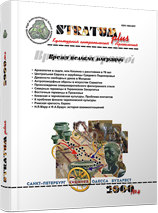О полихромном стиле позднеримского времени на территории Сарматии
On the Polychromic Style of the Late Roman Time in Sarmatia
Author(s): Sergey A. Yatsenko, Vladimir Yu. MalashevSubject(s): History, Archaeology, Cultural history, Visual Arts, Ancient World
Published by: Издательский дом Stratum, Университет «Высшая антропологическая школа»
Summary/Abstract: The article studies a range of items typical of the Northern Black Sea Coast and belonging to the polychromic style (also inaccurately called «cornelian») (pls. 2-4 + Catalogue). It is usually characterized by insertion of a large flat polished cornelian and a genuine list of stamped geometric decoration elements on the external plate. The authors do not attempt finding the place of origin of these items in other regions (all the findings on the territory from Iran to the Balkan peninsula cited in literature are very remote «prototypes» and analogs: pl. 6, 2-4). The detected centers of their production were Panticapaeum and Chersonese Tauricus, with local peculiarities in each of the two. The item of this style were produced, according to the dates proved by V.Yu. Malashev (Malashev, 2000), by four chronological groups (periods). The chronological group 1 (period II b – 2nd half of III c. A.D.) produced mainly articles of female costumes for the barbarians of the Western Crimea, while the groups 2 (period IIIa - late III – 1st third of IV cc.), group 3 (period IIIb – 2nd third IV c.AD – 372/375 – before the Hunns’ arrival) and group 4 (not earlier than mid. IV – early V cc.) mainly produced military equipment (harness, swords and daggers, belt buckles). Similar articles were worn by the local barbarised and barbarian population of the cities (especially in Panticapaeum), though the major part of these articles was meant to be gifted to the barbarian elite of the Steppes, and exclusively for the Iranian-speaking groups: Alans and «Tauro-Scythians» (the neighbouring Germans and Caucasus mountaineers did not use them at all). The noble graves containing these articles and found in Panticapaeum also have Sarmatian-Alan features (the bridle has tamga-signs of Sarmatian-Alan clans, bridle and swords were found in the graves of noble women, etc.) The style reaches its peak in the group 3, when articles of various destinations were produced, they increased in number and their decoration became most various. The spread of the articles at different stages (pl. 1) partly reflects military and political rivalry of Panticapaeum and Chersonese Tauricus. At first the Bosphorus supplies were meant for the Alans of the Central Caucasus foot mountains (articles of the group 2). Later, the Bîsporian Kingdom, after being defeated in three wars, sought allies among the nomads of the Low Don area (group 3) (the earlier period there yielded items produced in Chersonese). It was the time, probably, when these nomads became less dependant on the Alans of the Central Caucasus foot mountains. Some findings of the groups 2 and 3 are documented in the mouth of Danube, on the lands of the «European Alans» dependant on the Goths. After the Hunns’ intrusion separate items manufactured in this style reached the north (up the Volga river - Brody) and even Central Asia (Tugozvonovo in the mountains of Altai) where they were used and probably processed.
Journal: Stratum plus. Археология и культурная антропология
- Issue Year: 2000
- Issue No: 4
- Page Range: 226-250
- Page Count: 25
- Language: Russian
- Content File-PDF

